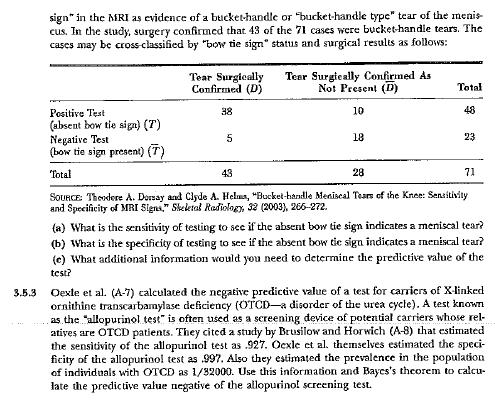3.5.2 In an article entitled Bucket-handle Meniscal Tears of the Knee: Sensitivity and Specificity of MRI signs,
Question:
3.5.2 In an article entitled "Bucket-handle Meniscal Tears of the Knee: Sensitivity and Specificity of MRI signs, Dorsay and Helms (A-6) performed a retrospective study of 71 knees scanned by MRI. One of the indicators they examined was the absence of the "bow tie
 sign" in the MRI as evidence of a bucket-handle or "bucket-handle type" tear of the menis- cus. In the study, surgery confirmed that 43 of the 71 cases were bucket-handle tears. The cases may be cross-classified by "bow tie sign" status and surgical results as follows: 3.5.3 Positive Test (absent bow tie sign) (T) Negative Test (bow tie sign present) (T) Total Tear Surgically Confirmed (D) Tear Surgically Confirmed As Not Present (D) Total 38 10 48 18 23 5 43 28 SOURCE: Theodore A. Dorsay and Clyde A. Helms, "Bucket-handle Meniscal Tears of the Knee: Sensitivity and Specificity of MRI Signs." Skeletal Radiology, 32 (2003), 266-272. 71
sign" in the MRI as evidence of a bucket-handle or "bucket-handle type" tear of the menis- cus. In the study, surgery confirmed that 43 of the 71 cases were bucket-handle tears. The cases may be cross-classified by "bow tie sign" status and surgical results as follows: 3.5.3 Positive Test (absent bow tie sign) (T) Negative Test (bow tie sign present) (T) Total Tear Surgically Confirmed (D) Tear Surgically Confirmed As Not Present (D) Total 38 10 48 18 23 5 43 28 SOURCE: Theodore A. Dorsay and Clyde A. Helms, "Bucket-handle Meniscal Tears of the Knee: Sensitivity and Specificity of MRI Signs." Skeletal Radiology, 32 (2003), 266-272. 71
(a) What is the sensitivity of testing to see if the absent bow tie sign indicates a meniscal tear?
(b) What is the specificity of testing to see if the absent bow tie sign indicates a meniscal tear?
(e) What additional information would you need to determine the predictive value of the test?
Step by Step Answer:

Biostatistics A Foundation For Analysis In The Health Sciences
ISBN: 9780471456544
8th Edition
Authors: Wayne W. Daniel






